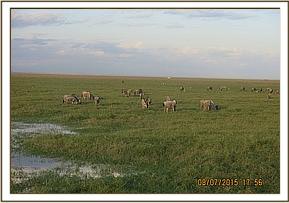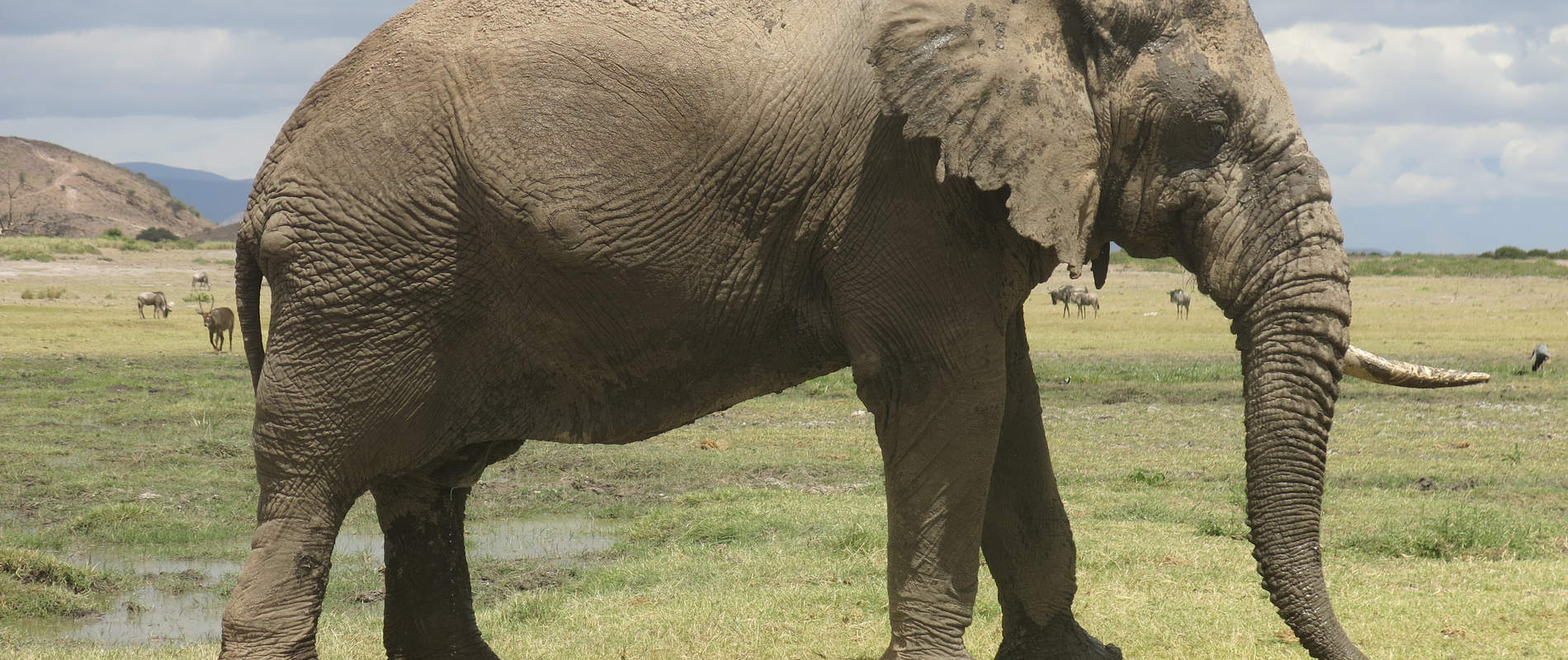VETERINARY CLINICAL INTERVENTIONS FOR THE SOUTHERN CONSERVATION AREA (MVU) – JULY 2015 Report by; Dr
VETERINARY CLINICAL INTERVENTIONS FOR THE SOUTHERN CONSERVATION AREA (MVU) – JULY 2015
Report by; Dr. Michael Njoroge
Monitoring and surveillance in Amboseli National Park and the surrounding ecosystem;
This month the Southern Conservation Area showed a marked decrease in the number of cases reported. This could be attributed to the increased surveillance within the area. During the month a combined team of Kenyan and Tanzania rangers performed a joint operation (cross border) to ensure reduction of poaching cases. The Veterinary Team also carried out the routine monthly aerial recce within the park and surrounding ecosystem.
Together with the Research Office, the team also embarked on identification of various sites within the Emali-Loitoktok highway for placement of wildlife corridor paths. This is aimed at reduction of road accidents involving wildlife along the 200km stretch. Ten sites were recommended and placement of the road signs is ongoing.
Routine vehicle patrols were also conducted within the month with the aim of;
- See the distribution of wildlife within the park
- Check for injured/sick animals within the park
- Check for any unnoticed carcasses within the park and its surrounding ecosystem
- Check for any unusual activities or happenings within the park and the surrounding ecosystem
No unusual sightings were seen except for one elephant carcass.
Areas visited included Kimana, Kitirua Porini, Lemongo and Satao among other areas within the park.
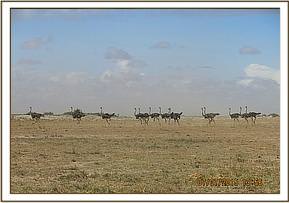

CASE#1 WILDLIFE MORTALITY INVESTIGATION (AMBOSELI ECOSYSTEM)
Date: 4th July 2015
Species: Zebra
Location: Kimana
History
The veterinary team within the month attended a suspected poisoning mortality case. The 2 mortality cases had occurred within a period of 1 week and showed signs of heavy hemorrhage which is an indication of poisoning. The animals were in good body condition (4 on a scale of 5) prior to death. The carcasses were recovered adjacent to a farm within the community land.
Samples
A water sample was collected from the drinking point. Kidney, liver and intestinal samples were collected and delivered to the laboratory for further analysis.
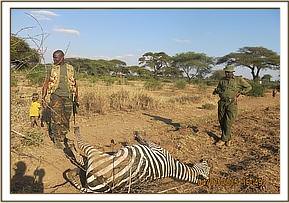

CASE#2 TREATMENT OF AN ELEPHANT WITH BULLET WOUNDS
Date: 5th July 2015
Species: Elephant
Sex: Male
Age: Adult (30-35 years)
Location: Ithumba
History
The DSWT pilot reported to have spotted a male elephant with a suspected arrow head injury to the right limb. The veterinary team had to locate and assess the elephant from the helicopter since the vegetation was thick. Plans were made on how to immobilize and treat the elephant. The elephant was in a thick bush thicket but relatively easy to dart using the helicopter. The elephant was pushed to relatively open ground for darting.
Immobilization, examination and treatment
The elephant was immobilized with 18mg Etorphine Hcl in a 3 ml dan - inject dart relatively easy from a helicopter despite the thick vegetation. The elephant went down on lateral recumbence after 5 minutes. The trunk was maintained patent using a piece of stick placed across the nostril entrances. The temperature was high hence plenty of water was doused on the elephant to keep the body temperatures low. The ears were used as blindfold.


On physical examination the elephant had penetrating wounds to both fore limbs and thoracic region. The wounds were septic and had necrotic tissue. The wound is likely to have been caused by a bullet and not an arrow as reported. The dead tissue was debrided and the wounds thoroughly cleaned using clean water and Hydrogen Peroxide. It was then lavaged using tincture of Iodine before topical antibiotic cream and green clay were applied to facilitate healing and avoid infection. The elephant was then injected with 100 ml Betamox, 1200 mg Clindamycin (Dalacin C) and 100 ml Dexamethasone at different sites intramuscularly. The entire operation lasted about 45 minutes.
Reversal
The anesthetic was reversed using 60mgs Diprenorphine Hydrochloride into the ear vein. However, the elephant did not get up as expected even after 30 minutes of waiting. An additional dose of 5ml Naltrexone was administered intravenously after 30 minutes. The elephant finally got up 20 minutes after administering naltrexone.
Prognosis
Good
CASE#3 EUTHANISA OF A GIRAFFE INJURED BY A VEHICLE
Date: 10th July 2015
Species: Giraffe
Sex: Female
Age: Sub-adult
Location: Isinet/Chyulu Ecosystem
History
A female giraffe was reported to have been hit by a car on the Emali-Loitokitok highway in the early morning hours. The KWS Loitokitok station reported to the veterinary team who attended to the case immediately for examination and treatment.
Immobilization, examination and management
The giraffe was recumbent and immobile on arrival at the scene. Immobilization was therefore not necessary for examination and assessment.
On physical examination the giraffe had suffered from a spinal injury (fracture) and a decision to euthanize the giraffe was made since the prognosis was poor. No clinical intervention could be done. The carcass was well disposed and the relevant authorities informed.
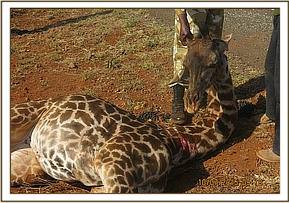

CASE#4 RESCUE OF AN ELEPHANT CALF
Date: 18th – 19th July 2015
Species: Elephant
Sex: Male
Age: Infant 2.5 – 3 years
Location: Kitirua- Amboseli ecosystem
History
The Cross-Border patrol team (Kenya/Tanzania-rangers) spotted an elephant calf 2.5 to 3 years old on its own. On further investigation, the calf was reported to have been abandoned by the mother after getting stuck in a water hole but apparently freed himself after sometime. The calf was in good condition and health.
The case was reported to the Veterinary Team who visited the site for decision making and action. A decision was made to rescue the calf but this could not be done until the following day due to the time required for making necessary arrangements for the rescue.
Tracking and Assessment
In the early hours of the following morning the team attended to the case. It took 5 hours of tracking the baby calf before he was finally spotted. On close observation a herd of elephants was spotted within the area. The calf joined the herd of elephants and since he could manage to feed by himself, the team decided to hold on the rescue operation and leave the calf in the wild under the protection of the herd hoping that the mother was in the herd.
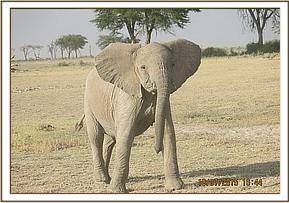

Monitoring of the calf will continue to ensure safety and survival of the calf.
CASE#5 RETREATMENT OF AN ELEPHANT WITH A SPEAR INJURY
Date: 20th July 2015
Species: Elephant
Sex: Male
Age: Adult (40 – 50 yrs)
Location: Kiboko - Chyulu
History
This elephant had been treated earlier for a serious right forelimb spear injury. Due to the severity of the wound a repeat treatment was necessary on this elephant. The Kiboko Rangers were sensitized and hence began an intensive search for the elephant when the time came. After several days of a thorough search, the elephant was spotted and the Veterinary Team immediately notified. Plans were made to airlift the vet and a ranger via a helicopter to the site where after examination, a decision was made to immobilize and treat the elephant.
Darting was relatively easy from the DSWT helicopter though the terrain was rough and bushy.
Immobilization, examination and treatment
The elephant was immobilized using 17 mgs Etorphine Hydrochloride in a 3cc dart using the Dan-inject system from the helicopter. Full immobilization took place after 5 minutes and he fell in a dog sitting position. The rangers helped flip the elephant to right lateral recumbency for easy access to the wound and safety of the elephant. The trunk was maintained patent using a piece of stick placed across the nostril entrances. The ears were used as blindfold. Plenty of water was doused on the ears and the entire body to help cool the elephant during the operation.
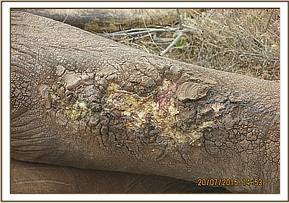

On examination, the wound was on its way to recovery and the condition had greatly improved. The dead tissue was debrided and removed. The wound was then thoroughly cleaned using water and Hydrogen Peroxide.
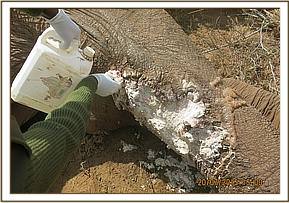

It was then lavaged using tincture of Iodine before topical antibiotic cream, spray and green clay were then applied into the wound to facilitate healing and avoid infection. The elephant was then injected with 200 ml Amoxcycillin L.A and 100 ml Flunixine meglumine at different sites intramuscularly. The entire operation lasted about 20 minutes.
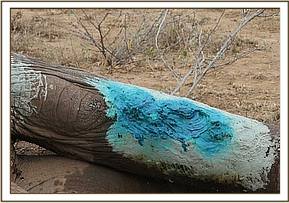

Reversal
The anesthetic was reversed using 54mg Diprenorphine Hydrochloride into the ear vein. The elephant took about 4 minutes to be fully awake from the anesthesia and walk away from the site.
Prognosis
Prognosis is good.
Acknowledgements
The Southern Conservation Area Mobile Veterinary Unit is grateful to all individuals who played a role in assisting us towards achieving our goal. Many thanks to The David Sheldrick Wildlife Trust, The Samuel J and Ethel Lefrak charitable trust and The Kenya Wildlife Service for their continued support to this unit which aims at immediate response to clinical intervention, wildlife rescues and alleviating wildlife suffering.
